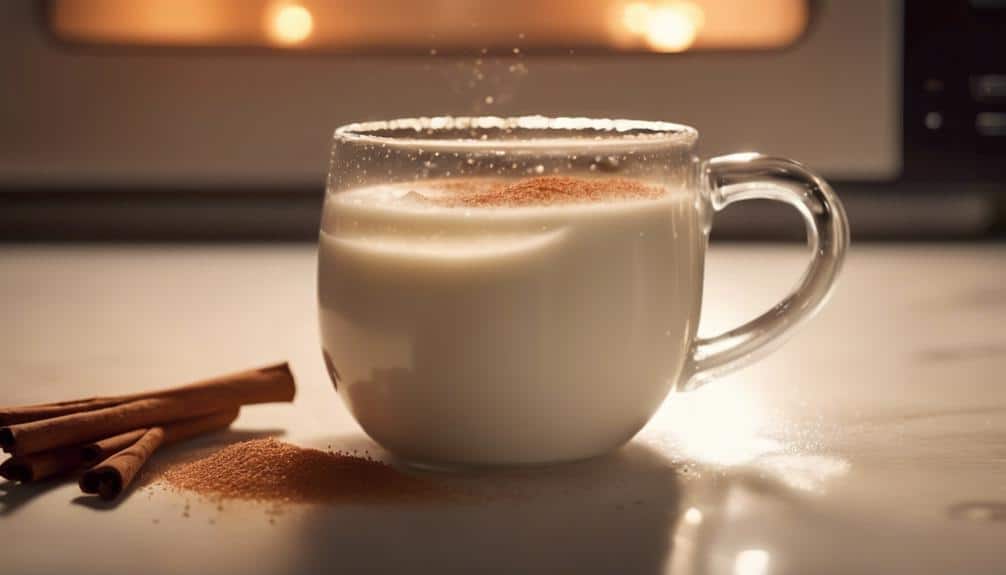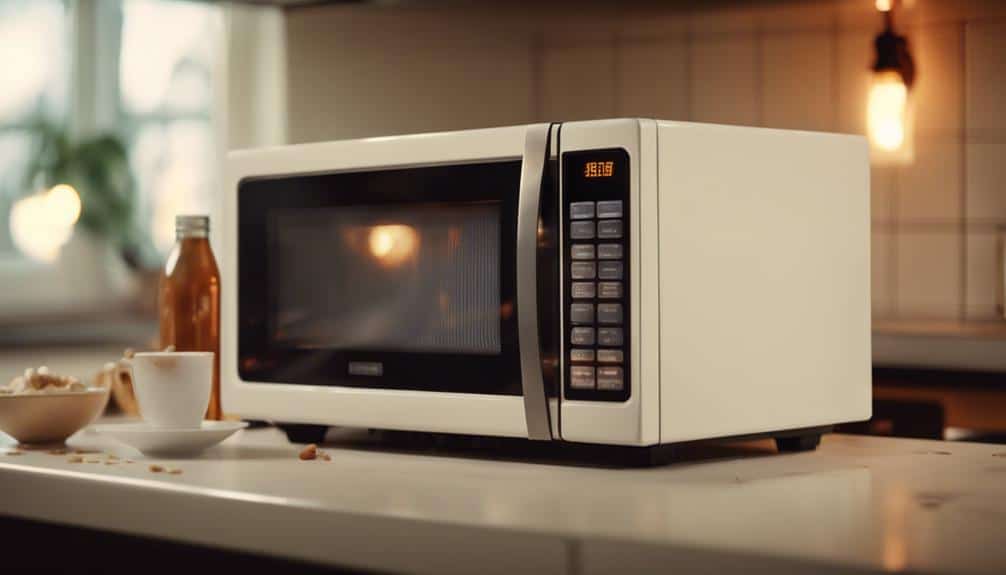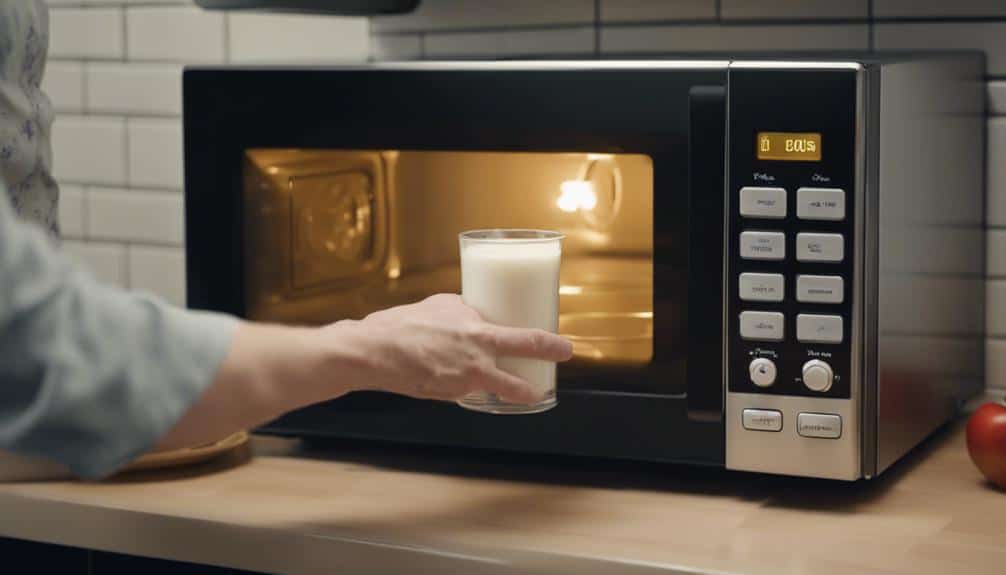Quick and Easy Microwaved Milk

Microwaving milk may seem like a simple task, but getting it just right can make a big difference in your beverages and dishes. The proper technique can mean the distinction between a creamy, satisfying drink and a curdled mess. By grasping the nuances of microwaving milk, you can elevate your cooking and elevate your dishes to a whole new level. So, let's explore the ins and outs of microwaving milk to make certain that every sip and bite is a delightful experience.
Benefits of Microwaving Milk
Microwaving milk improves its nutritional profile while effectively maintaining essential nutrients. When heating milk in the microwave, it's vital to use a microwave-safe container to prevent any harmful chemicals from leaching into the milk. Stirring the milk before and during heating ensures even distribution of heat, preventing hot spots that could lead to nutrient loss. This method isn't only convenient but also a time-saving approach to enjoying warm milk quickly.
Guaranteeing the safety of the milk during the microwave process is essential to prevent bacterial growth and maintain its nutritional value. By following safety precautions such as using the right container and stirring adequately, microwaving milk can be a safe and efficient way to enjoy this nutritious beverage. Additionally, microwaving milk is an energy-efficient method compared to traditional stovetop heating, making it a preferred choice for those looking to save time and resources.
Proper Heating Techniques
Implementing appropriate heating techniques is essential when microwaving milk to maintain its nutritional quality and prevent overheating. When heating milk in the microwave, using medium-high settings and short 15-second intervals is vital to avoid scorching or overheating.
Stirring the milk after each heating interval is necessary to guarantee uniform heat distribution and prevent hot spots from forming. It's important to stop heating the milk once steam starts rising from it, as this indicates the milk is nearing its boiling point and further heating may lead to scorching.
Adjusting the heating duration based on the quantity of milk being heated is recommended, with regular stirring to prevent scorching. Using a thermometer to check the milk's temperature and following recommended heating times for different quantities will help achieve the desired results without compromising the milk's quality.
Proper heating techniques are key to enjoying perfectly microwaved milk every time.
Preventing Curdling and Burning

When microwaving milk, it's important to stir it frequently to prevent curdling and guarantee uniform heating.
Overheating should be avoided by using short intervals and stopping when steam starts rising.
Choosing a microwave-safe container and leaving space at the top can help prevent burning and spillage during the heating process.
Curdling Prevention Tips
To prevent curdling and burning when microwaving milk, it's essential to carefully control the heating process and avoid introducing acidic ingredients that can induce unwanted separation of proteins from the liquid.
- Use short intervals: Heat milk in short bursts to prevent overheating and denaturation of proteins.
- Stir frequently: Distribute heat evenly to minimize the risk of curdling.
- Avoid acidic ingredients: Lemon juice or vinegar can cause curdling, so refrain from adding them to milk in the microwave.
Avoiding Burning Issues
To guarantee the proper heating of milk in the microwave while preventing curdling and burning issues, frequent stirring is necessary. Curdling can be avoided by adjusting power levels to prevent overheating.
Choose a microwave-safe container to distribute heat evenly and prevent hot spots. Use a thermometer to monitor the milk's temperature and avoid scorching.
To prevent burning, stop heating when steam rises from the milk and allow it to stand for a few moments before consumption.
Retaining Nutrients in Milk
In the process of microwaving milk, the rapid heating method plays an important role in preserving essential nutrients such as calcium and vitamin D. This efficient method of quick heating helps in maintaining the milk's nutritional value by minimizing nutrient loss during the heating process.
Studies have shown that microwaving milk at moderate temperatures for shorter durations is more effective in preserving its vitamin content compared to prolonged exposure to heat on the stovetop. By retaining nutrients in microwaved milk, it guarantees that the milk maintains its health benefits, making it a convenient and efficient option for consumption.
- Microwaving milk helps retain essential nutrients like calcium and vitamin D due to its quick heating process.
- Quick heating in the microwave minimizes nutrient loss compared to prolonged exposure to heat on the stovetop.
- Preserving nutrients in microwaved milk is important for maintaining its health benefits, making it a convenient and efficient heating method.
Ideal Heating Time Intervals

When microwaving milk, finding the ideal heating time is important to prevent boiling and overheating. Short intervals of 15-30 seconds allow for gradual heating and help maintain the milk's quality.
Adjusting the heating time based on the quantity of milk and desired temperature guarantees a perfect result every time.
Optimal Heating Time
During microwave heating of milk, adjusting the time intervals based on the wattage of the microwave is crucial to prevent overheating or scorching. To achieve best results, consider the following:
- Use short intervals, like 15 seconds, to control the heating process effectively.
- Monitor closely for steam rising as an indicator to stop heating and maintain the desired temperature.
- Stir the milk after each heating interval to guarantee even distribution of heat and prevent hot spots.
Prevent Milk Boiling
To prevent milk from boiling while heating in the microwave, adhere to short 15-second intervals and stir between each increment for even heat distribution.
Overheating can be avoided by stopping the heating process once steam starts to rise from the milk.
Choosing a microwave-safe container with a gap at the top helps prevent spillage during heating.
Adjusting the heating time according to the quantity of milk and the desired temperature is important for best results.
By following these steps carefully, you can guarantee that your milk is heated efficiently without the risk of boiling over.
Enhancing Flavor With Additives
Enhance the flavor of microwaved milk by adding hot chocolate powder or syrup for a rich and indulgent treat. To further elevate the taste, consider the following additives:
- Vanilla Extract: Add a dash of vanilla extract for a subtle sweetness that complements the creaminess of the milk.
- Cinnamon or Nutmeg: Sprinkle either cinnamon or nutmeg into your microwaved milk for a warm and comforting spiced flavor that evokes cozy feelings.
- Honey or Maple Syrup: Drizzle honey or maple syrup into your milk for a touch of natural sweetness that enhances the overall richness of the drink.
Experimenting with these additives allows for a customizable experience tailored to your preferences. Whether you prefer the decadence of hot chocolate, the earthy notes of matcha powder, or the warmth of cinnamon, these options provide a spectrum of flavors to transform your microwaved milk into a delightful indulgence.
Safety Measures for Microwaving Milk

For safe microwaving of milk, select a container that's microwave-safe to prevent accidents and ensure proper heating. Using a microwave-safe container is essential to avoid any mishaps during the heating process.
When heating milk in the microwave, it's best to do so in short intervals to prevent overheating and to have better control over the temperature. Stirring the milk after each heating interval helps distribute the heat evenly, reducing the chances of hot spots and ensuring uniform heating.
Be cautious of steam when handling heated milk to prevent burns or scalding injuries. Allow the milk to stand for a few moments after heating to achieve a consistent temperature throughout and to avoid accidental spills.
Quick and Easy Milk Recipes
When preparing quick and easy milk recipes, it's important to consider the versatility of microwaved milk for creating a variety of delicious and convenient dishes.
- Whip up a latte: Heat a cup of milk in the microwave for 30 seconds, then pour over espresso for a quick caffeine boost.
- Indulge in hot chocolate: Warm milk in the microwave, stir in cocoa powder, and enjoy a rich and comforting cup of hot chocolate.
- Nourishing oatmeal: Create a creamy bowl of oatmeal by warming milk in the microwave and mixing it with oats for a nutritious and filling breakfast.
To make sure the milk is heated evenly, pause to stir every 15 seconds and monitor the temperature to avoid boiling. Adjust the heating time based on the quantity of milk and the microwave's power to achieve the desired warmth. With these quick and easy recipes, a delicious and satisfying treat is just moments away.
Conclusion
To sum up, microwaving milk is a convenient and efficient method for preparing warm and nutritious beverages or meals. By following proper heating techniques and taking safety measures, you can prevent curdling and retain essential nutrients in the milk.
With quick heating intervals and the option to enhance flavor with additives, microwaving milk allows for easy and versatile cooking. It's a practical solution for busy individuals looking to enjoy delicious and comforting recipes in a timely manner.





